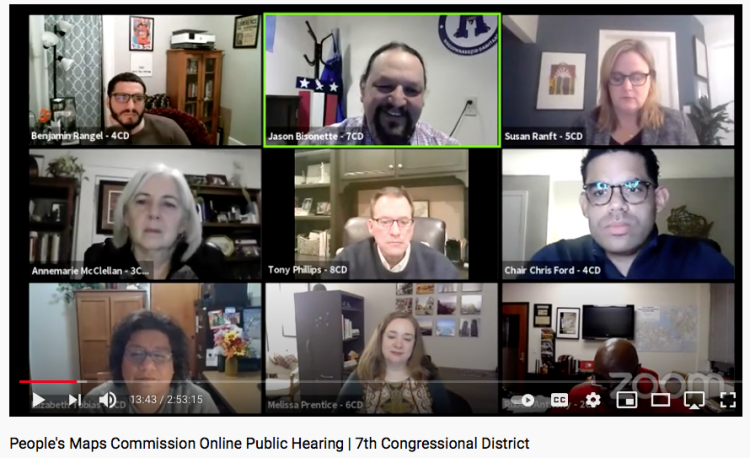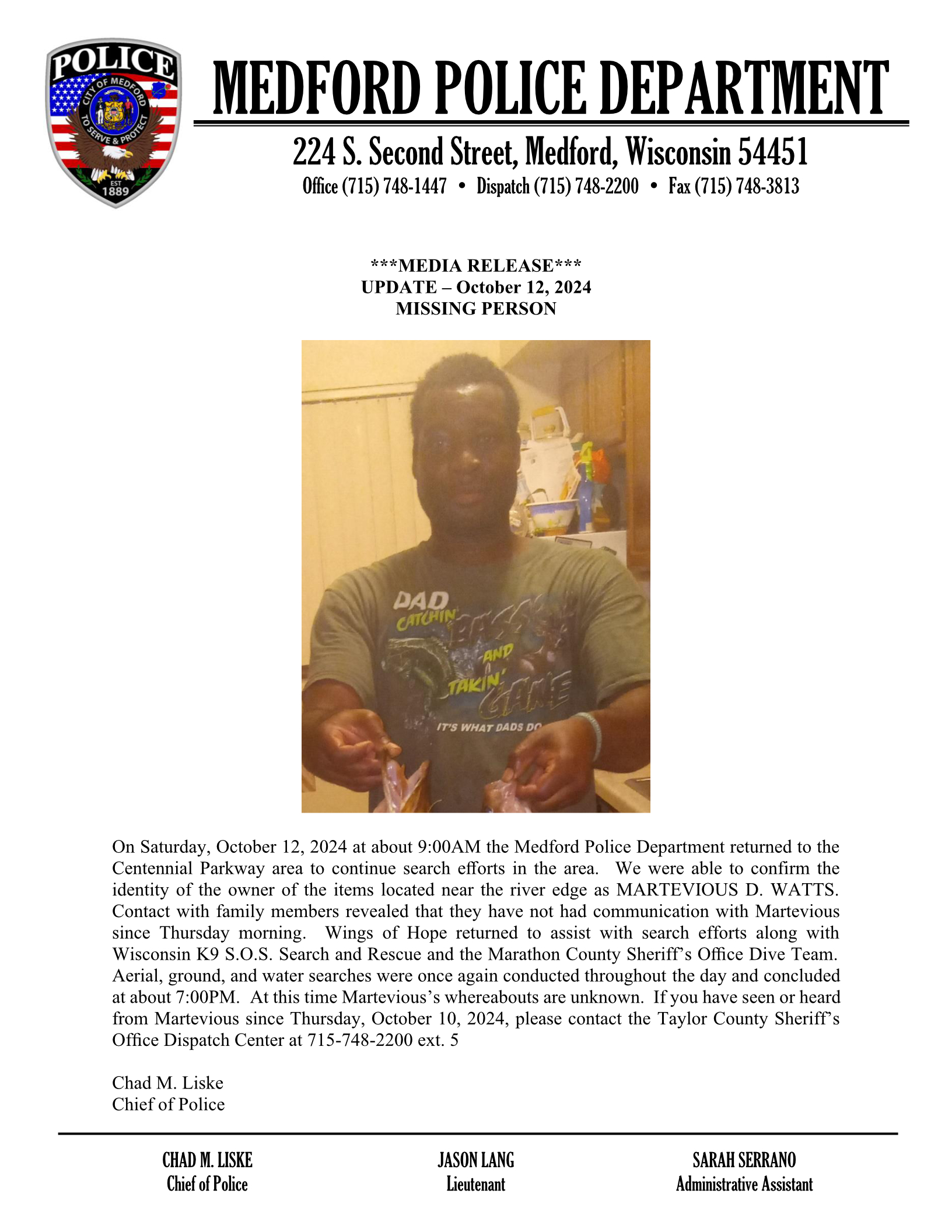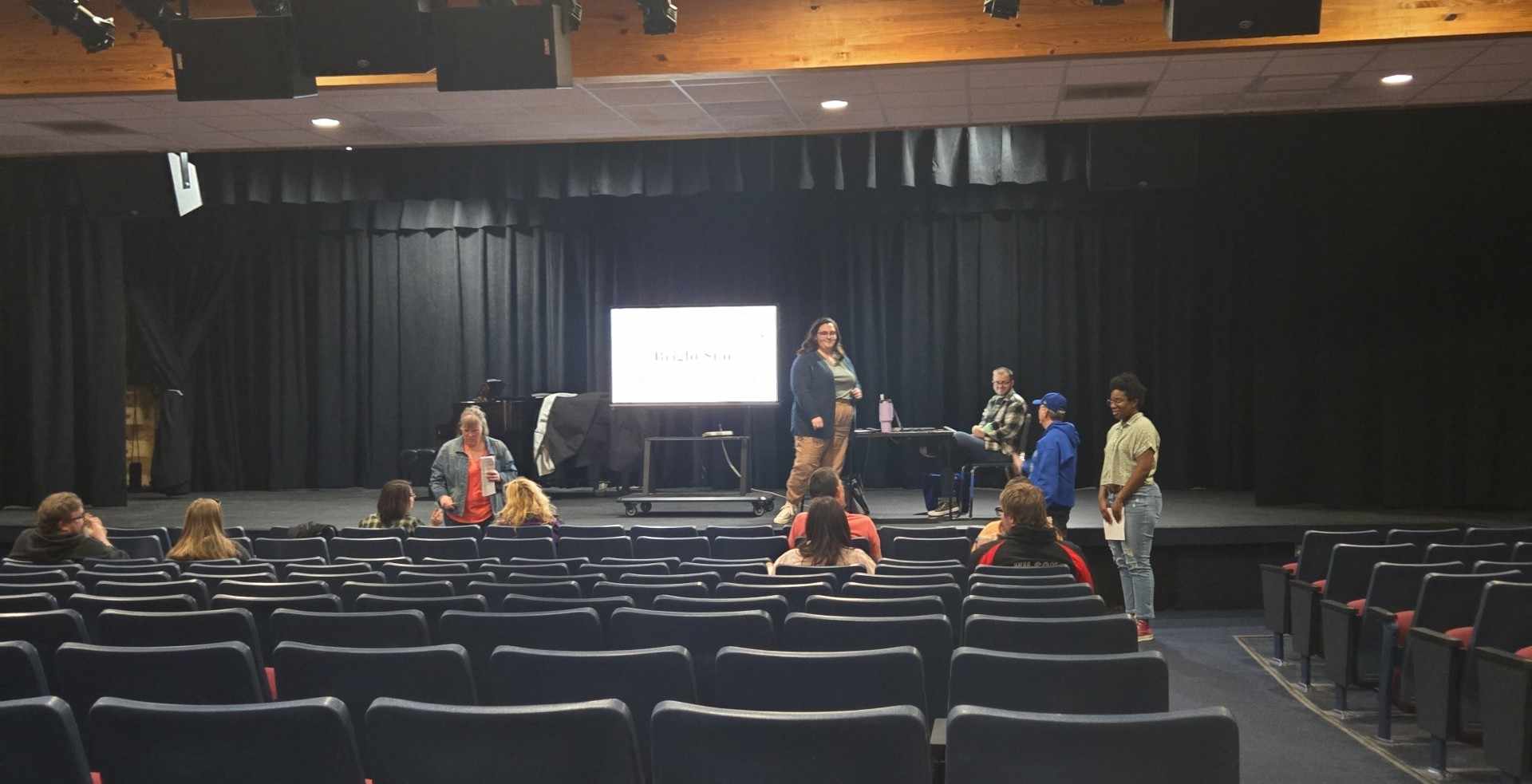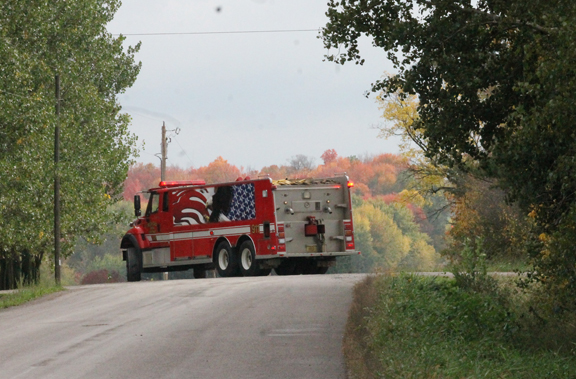Voters voice support for non-partisan maps


Jason Bisonette (center, top row), who represents the 7th Congressional District on the People’s Maps Commission, speaks to other commission members at a virtual public hearing meeting Jan. 28, about redistricting issues.
By Kevin O'Brien, Tribune Phonograph
When the boundaries of the 7th Congressional District were last redrawn in 2011 – along with the maps for state Senate and Assembly districts – the process left many voters feeling displaced.
People like Ann Stevning-Roe, of Marshfield, found themselves living in a community that was suddenly split between two different Assembly districts and two separate state Senate districts. Wood County, where she lives, was sliced up into four Assembly districts, three Senate districts and two Congressional districts, as a result of the redistricting process.
Before 2011, Marshfield and most of Wood County, fit neatly into one Assembly district, one Senate district and one Congressional district. Roe spoke to the People’s Maps Commission Jan. 28, about the impacts of living in a community with split representation in Madison.
“Since 2011, most people in Marshfield, don’t even know who their state senators are, because they don’t come here,” she said. “To my knowledge, we have not seen our state senator since 2011.”
Every 10 years, the maps that determine how citizens are represented in the U.S. House of Representatives and in the state legislature, are redrawn to account for population shifts in the U.S. Census. In Wisconsin, the legislature draws these maps, with approval needed by the governor, but oftentimes, final versions are made by the courts, because elected offi cials cannot agree.
The maps approved in 2011, have been the subject of “years of litigation, costing taxpayers millions of dollars in legal fees,” according to an executive order issued by Gov. Tony Evers, when he created the People’s Maps Commission.
Roe, an attorney who was a plaintiff in a 2016 federal case accusing the state of illegal gerrymandering, said the current maps violate principles enshrined in the state constitution, such as the requirement that they be as “compact as practical.” (Senate District 29 includes the east side of Marshfield and stretches all the way to Hayward).
Because these maps are often drawn to secure partisan advantage, Roe said incumbents are protected from any serious challenges. In 2018, 69th Assemblyman Bob Kulp, of Stratford, ran unopposed, and in 2020, Rep. John Spiros, of Assembly District 86, had no opponent.
“Uncompetitive districts disenfranchise the voters and they perceive there is no use in voting,” said Roe.
Roe was one of 20 residents from Wisconsin’s 7th Congressional District, who spoke to the People’s Maps Commission during the virtual public hearing, to gather input regarding the upcoming redistricting process.
The commission is an advisory-only body consisting of nine appointed members, including one from each of Wisconsin’s eight congressional districts (plus a second member for the First District).
After conducting public hearings for each of the congressional districts, the commission plans on submitting a proposed map to the legislature for possible approval later this year.
The 7th Congressional District, currently represented by Republican Tom Tiffany, includes over 710,000 residents in the central and northwestern portions of Wisconsin, with the boundaries stretching all the way from Necedah, in the south, to Superior, in the north.
The district includes 21 entire counties, including Chippewa, Taylor, Clark and Marathon, and portions of five counties along its southern border.
Jason Bisonette, a member of the Lac Courte Oreilles Band of Ojibwe and dean of students at LCO Ojibwe School, spoke to other members of the commission about the general character of people in the mostly rural 7th District.
“For many people around here, the idea of gun control means keeping your gun safety on, muzzle awareness, and knowing what your target is and what’s beyond,” he said.
Bisonette said even though people are split along party lines, they put those differences aside when responding to issues like severe weather and poverty.
“Despite all of the polarized positions we see on the news, I really believe that we have the ability to come together when times are tough,” said Bisonette.
One political factor that unites 7th District residents, is the geographic distance from Madison, and the lack of leverage, compared to more populated areas in the southeastern part of Wisconsin. Bisonette said this can be seen in everything from unfunded mandates on public schools, to lack of adequate healthcare and insufficient environmental laws.
“The reality is, we’re all subject to the decisions made by a group of people from downstate,” he said. “For many years, I’ve said, ‘We’re living a legacy of isolation up here.’ Certainly for tribal people, but for many other folks, as well.”
Before taking public comments, the commission heard from two people involved in establishing non-partisan redistricting commissions, in the neighboring states of Iowa and Michigan.
Katie Fahey, executive director of Voters Not Politicians, spoke about the group’s 2018 ballot initiative in Michigan, that resulted in the creation of a non-partisan commission to redraw the state’s political maps. Fahey said the commission is comprised of 13 members, including two each from the Republican and Democratic parties, and nine non-affiliated members.
She said the line-drawing process is focused on being “fair, impartial and transparent,” with no motive to favor one political party over another.
Fahey compared Wisconsin’s 7th to the Upper Peninsula of Michigan, where people often feel “dictated to by the bottom part of the state,” while their own interests are ignored. She said “fair maps” like the one in Michigan, are designed to maximize every voter’s voice in state and federal decisions.
Michael Li, lead legal counsel for the Brennan Center of Justice’s Democracy Program, discussed Iowa’s redistricting process, which is often seen as a model for non-politicized map-drawing. Iowa has civil servants at the Legislative Service Agency (LSA) draw both the congressional and legislative maps, with assistance from a citizens advisory commission that holds hearings.
Li said the process is “very mechanical,” with rules in place to prevent the favoring of one party over another or diluting the voting strength of certain groups.
“If you talk to the people at the LSA, they don’t feel like they’re making political decisions,” he said. “They feel like they’re just applying formulas.”
Iowa’s state legislature must still approve the maps by an up-or-down vote, but only minor technical corrections can be made by lawmakers. If a map is rejected, LSA draws a second map and if that is also voted down, the legislature can draw its own map, subject to the same strict rules.
Li said the legislature has never rejected a map since the system was in place in 1980.
By contrast, almost all of Wisconsin’s congressional and legislative maps, have been legally challenged over the decades, because of partisan wrangling. Since 2016, the num- ber of states with redistricting commissions has more than doubled.
Li said there’s been a “wave of reform” since the 2011 redistricting process, and the desire for non-politicized maps has become “increasingly bipartisan.”
“It’s an issue that resonates with people, because I think people feel like the system is broken and redistricting has something to do about it, and the political class rigs the process,” said Li.
Out of Wisconsin’s 72 counties, 50 of them expressed support for a non-partisan redistricting process, either through county board resolutions or advisory referendums.
Voters from all across the 7th District, from Ashland to Wausau, and Ladysmith to Merrill, spoke during the hourlong public comment period. Although they came from farfl ung areas, they expressed a common theme: the need for “fair maps” in upcoming elections.
Bob Maline, in Hudson, who identified himself as a lifelong independent voter, said one of the best ways to address Wisconsin’s “toxic political and cultural divide,” is to make sure the legislative maps truly mirror the political preferences of the statewide electorate.
“If 52 percent of the Assembly votes are cast for Party A, then Party A should have 52 percent of the representatives in the Assembly,” he said.
It was pointed out by more than one speaker, that election results since the 2011 redistricting, have not closely reflected the numbers of votes cast for candidates of the two parties.
Roger Utnehmer, Wausau, said Democratic candidates for the legislature in 2020, received 47 percent of the votes across the state, but they only won 38 percent of the available seats. He said that disparity was also evident in the 2018 and 2016 elections.
“That is simply not fair,” said Utnehmer. “Elections are rigged, because elected officials are selecting their voters, instead of allowing voters to select their elected officials.”
Kim Butler, a Democrat from Balsam Lake, who has twice run unsuccessfully for a State Assembly seat, said the 7th Congressional District itself was reconfigured to make it safer for Republican incumbents. As a side effect, she said almost 20 percent of the counties in the 7th are partially in other districts.
“Split districts confuse voters, and make it harder for both parties to campaign and organize,” said Butler.
Calvin Dexter, Wausau, echoed comments made by many on both sides of the political spectrum by saying that “democracy itself is under attack in this country.” He said unfair electoral practices are creating a situation like the former Soviet Union, when the Communist Party won all the elections.
“Americans are rightly concerned about rigged elections, but elections are not rigged by fraud, but by voter suppression and partisan gerrymandering,” said Dexter.
Written comments related to the 2021 redistricting plan can still be submitted on the People’s Maps Commission website, govstatus.egov.com/peoplesmaps.



